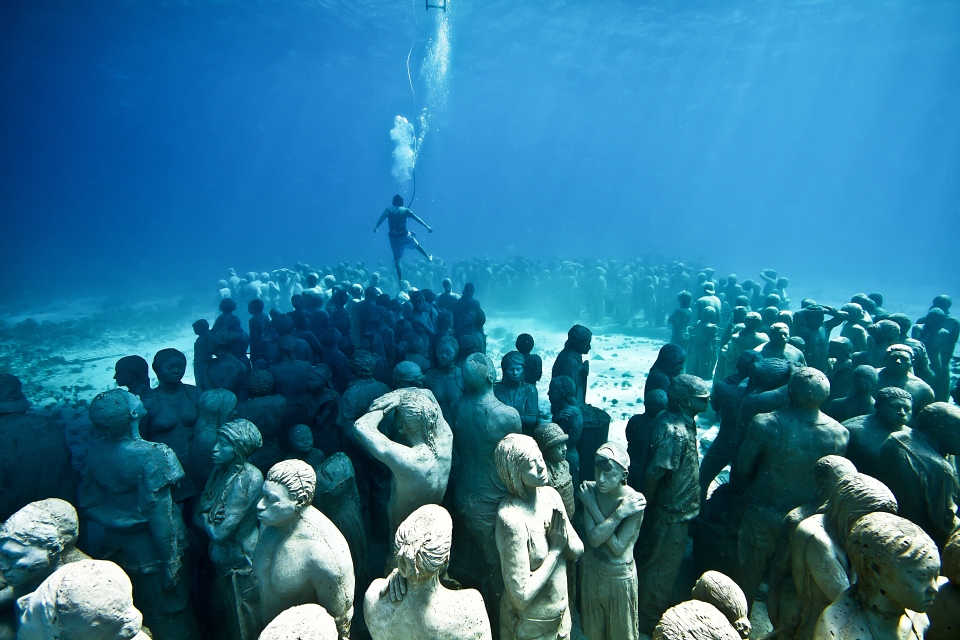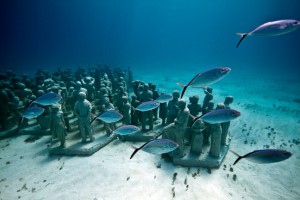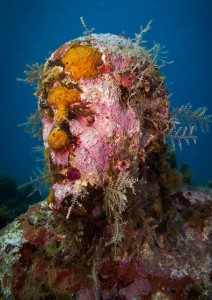It’s worth looking at this recent video post by the Huffington post.
It is about a series of art installations by artist Jason DeCaires Taylor, who has been making underwater sculptures that double as artificial reef habitat off the Mesoamerican barrier reef (see video for more information). According to Taylor’s website, the sculptures are created from a pH-neutral cement and are designed to promote coral growth and last for hundreds of years (http://www.underwatersculpture.com/about/overview/). His photos certainly look impressive, with fouling organisms completely encrusting the statues. The photo below shows the progression of Taylor’s underwater art through time, from the model he used for the statue to the installed statue with living additions.

This same story has been picked up by National Geographic and he has given a TED talk that can be viewed here.
But – you might be wondering – is this too good to be true? Are artificial reefs really as “good” as natural reefs? What are the wider social effects of an art installation like this?
Great questions. Of course, to fully and properly answer these questions, social and natural scientists would need to study this system and others like it. However, in their review of the literature on artificial reefs, Bohnsack and Sutherland (1985) summarize how artificial reefs compare to natural reefs:
- There is a scientific consensus that artificial reefs are “effective fish attractants.”
- In almost all cases, artificial reefs had similar community structures as natural reefs, and in most cases artificial reefs also had greater fish abundance and biomass than natural reefs of similar size.
- There have, indeed, been cases of artificial reef failure – and the number of artificial reef failures is probably underreported.
- In the USA, many artificial reefs are constructed of waste materials like coal ash and tires – but this is not ubiquitous worldwide; in Japan, for example, artificial reefs are carefully engineered to boost fish stocks.
- Particularly in the United States, not enough attention is paid to optimal design, construction, and placement of artificial reefs.
More recent studies have found that:
- Artificial reefs have similar compositions of organisms as natural reefs given time (in this study, 119 years) as long as the physical structures are comparable (Perkol-Finkel et al. 2006).
- Finally, a more recent study found that having vertical rather than horizontal surfaces was more important for encrusting organisms than whether a reef was artificial or natural (Knott et al. 2004).
The general consensus about the ecological impacts of artificial reefs v. natural reefs are thus that many artificial reefs are poorly planned and use waste materials, but if the reefs are well-planned and have similar (vertical) structure as natural reefs, that artificial reefs can be as good or better than natural reefs at fish recruitment and overall biodiversity (Bohnsack and Sutherland 1985, Knott et al. 2004, Perkol-Finkel et al. 2006).
And, the social implications of artificial reefs? Early studies of artificial reefs ignored their socio-economic impacts. But, artificial reefs are constructed “primarily for the purpose of producing social and/or economic benefits,” (Sutton and Bushnell 2007, page 841) and so it is ironic that the literature has focused on ecological implications without paying as much attention to their explicit implications for human lives. This is changing, however; a literature review by Sutton and Bushnell (2007) finds a number of interesting socio-economic results regarding artificial reefs:
- Artificial reefs tend to be used primarily by recreational fishers and divers (in the USA, Australia), artisanal fishers (in the Philippines), or commercial fishers (in Japan).
- The economic impact can be substantial: a study by Johns and coauthors found that artificial reefs in a single county in southeast Florida produced $962 million in sales, $502 million in income, and 16,800 full- and part-time jobs (Johns et al. 2001).
- Catch rates on artificial reefs tend to be higher – but it is not clear whether this is due to an increase in fish, or simply recruiting existing fish stocks from elsewhere.
- It is unclear whether the tourism dollars from artificial reefs are due to increased tourism or redistribution of tourism dollars from other areas.
- The construction of artificial reefs can exclude certain fishing gear use and thus affect property rights schemes.
- As a result of this and other factors, artificial reefs often become a focal point of conflict between user groups.
- Liability issues could ensue if a user of the artificial reef is injured and pursues legal action against the group that constructed the reef.
From the findings above, it is clear that artificial reefs can have unintended consequences (legal liability, exclusion of gear types, redistribution of tourism dollars) but do (at least) seem to have strong ecological benefits and potentially lucrative economic benefits for local fishers and the tourism industry.
So, are Jason DeCaires Taylor’s sculptures as cool as they sound? The answer to such questions is always uncertain, particularly since it is unclear what the broader effects are of having a British artist install large-scale art in other countries. But – if the case of his art installation is comparable to the literature on artificial reefs, the answer is, “probably yes!” His sculpture garden (which is very vertical with lots of structural complexity) is probably attracting fish, recruiting a similar biotic community as natural reefs, and bringing in more tourist dollars to the area.
Note: all photos in this blog are from Jason DeCaires Taylor’s website, which has more information about his sculptures: http://www.underwatersculpture.com/sculptures/the-silent-evolution/.
Cited:
Bohnsack, James A., and David L. Sutherland. “Artificial reef research: a review with recommendations for future priorities.” Bulletin of marine science37.1 (1985): 11-39.
Johns GM, Leeworthy VR, Bell FW, Bonn MA. Socioeconomic study of reefs in Southeast Florida—final report. Report prepared for Broward County, Palm Beach County, Miami-Dade County, Monroe County, Florida Fish and Wildlife Conservation Commission and National Oceanic and Atmospheric Administration. Hazen and Sawyer: Environmental Engineers and Scientists, 2001.
Knott, N. A., et al. “Epibiota on vertical and on horizontal surfaces on natural reefs and on artificial structures.” Journal of the Marine Biological Association of the UK 84.06 (2004): 1117-1130.
Perkol-Finkel, S., N. Shashar, and Y. Benayahu. “Can artificial reefs mimic natural reef communities? The roles of structural features and age.” Marine environmental research 61.2 (2006): 121-135.
Sutton, Stephen G., and Sally L. Bushnell. “Socio-economic aspects of artificial reefs: Considerations for the Great Barrier Reef Marine Park.” Ocean & Coastal Management 50.10 (2007): 829-846.







